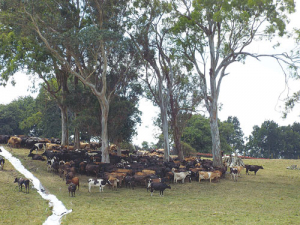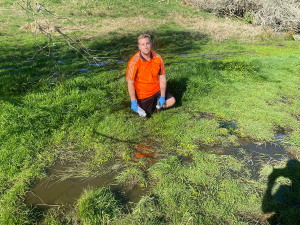Dairy cows in all regions are affected by heat stress during summer. The comfort zone of a cow is 4-20°C, about 10-15° lower than the comfort zone of a human.
According to DairyNZ, heat stress occurs when an animal’s heat load is greater than its capacity to lose heat; cows feel hot 10-15°C sooner than humans.
High air temperature, humidity, solar radiation and low air movement contribute to increased risk.
High relative humidity decreases evaporation and reduces the cow’s ability to lose heat by sweating and breathing.
When air temperature exceeds about 21ºC and relative humidity exceeds 70% cows begin to reduce their feed intake and milk production falls. Jerseys tolerate heat better, with production losses insignificant until 25ºC.
Cows radiate heat during the night to the cooler surroundings. Warm cloudy nights can reduce cooling, increasing the risk of heat stress.
As in humans, cows likely experience headaches, irritability and lethargy when they are too hot and have insufficient water. To cope with heat, cows use a variety of strategies including:
- increased breathing rate and sweating
- increased water intake
- decreased feed intake and decreased milk production
- change in milk composition, e.g. fat % and protein % declines
- change in blood hormone concentration, e.g. increased prolactin.
Their behaviour also changes: cows seek shade, crowd together to shade each other, refuse to lie down and stand in water or next to water troughs.
To minimise impacts on productivity and protect cow comfort consider the following:
Water
Lactating cows will typically need at least 100L/cow/day and will drink two to six times per day. Ensure flow rates to troughs are high enough that the trough never runs dry. Most cows drink soon after milking, so install water troughs in races to meet that need.
Feed
Ensure summer pasture is of high quality. Feed with high fibre content can increase the heat of fermentation in the rumen, increasing the heat load on the cow (e.g. non-irrigated summer pasture). Provide supplementary feed at night when it is cooler.
Shade
Use paddocks with shade trees during periods of heat stress – ideally 5m2 of shade per cow, to minimise competition. Provide shade at the shed if possible. Install shade cloth in off-paddock facilities.
Management
Reduce the walking distance and speed to the dairy. Reduce the time spent in unshaded yards. Minimise handling stress. Isolate cows most severely affected by heat stress and provide shade and cooling. Milk earlier in the morning and later in the afternoon, or consider once-a-day milking.
Cooling
Sprinklers can be used over the dairy yard to wet the cows’ coats and aid evaporative cooling for two to six hours after milking. However, sprinkling can increase the humidity around the cows, especially when they are held close together. The effectiveness of sprinkling depends on the removal of water vapour by air movement, ideally by using a fan.


















